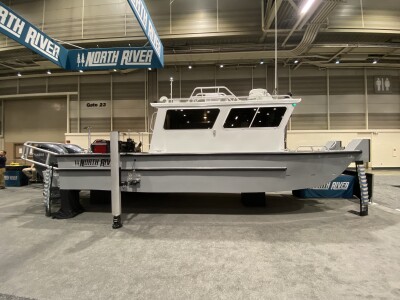The first wind turbines installed in U.S. Atlantic federal waters began turning in December, little more than a month after the drama of Ørsted canceling a flagship project.
Ørsted’s Oct. 31 announcement backing out of its 1,100-megawatt Ocean Wind project off New Jersey shocked industry advocates and critics alike. Yet on Dec. 6 Ørsted turned on its first of 12 turbines for the South Fork Wind project, 35 miles off the east end of Long Island, laying claim to the first energy flowing from a federal waters wind power project into New York state’s power grid. With completion anticipated in 2024, South Fork would have a maximum nameplate power rating of 130 megawatts.
That same day Avangrid, a partner with Copenhagen Infrastructure Partners in the 806-MW Vineyard Wind project, said they had erected five of 62 GE Haliade-X turbines and aimed to be delivering first power into Massachusetts by the end of 2023.
“Our team has worked tremendously hard, through nights, weekends, and holidays to put us in the position to deliver the first power from Avangrid’s nation-leading Vineyard Wind 1 project before the end of the year,” said Avangrid CEO Pedro Azagra. “Today, we have fully installed the first five turbines of this historic project, representing a new frontier for climate action and the clean energy revolution in the United States.”
The first five Vineyard turbines are nameplate rated for 65 MW. Before generating its first power deliveries by export cable to Barnstable, Mass., on Cape Cod, Avangrid said it “must complete several critical tests and technical milestones, including final testing of the array and export cables, and energization of the offshore substation which is one of the largest built in the global offshore industry.”
The schedule gave hope to offshore wind advocates, after months of bad news like Ørsted’s sudden exit from Ocean Wind because of escalating costs.
“Offshore wind is the single biggest lever we can pull to address the climate crisis while strengthening our regional economy, protecting ratepayers, improving public health, and creating high-quality jobs and equitable access to economic opportunity,” said Elizabeth Turnbull Henry, president of the Environmental League of Massachusetts.
Yet U.S. offshore marine service companies – long experienced in oil and gas, and eager to apply their expertise to wind power – are newly cautious about the new industry’s financial turbulence. They think the wind power industry still has a promising future off the East Coast and in the Gulf of Mexico, where the future market for wind energy will be with the region’s heavy industry.
Ørsted’s sudden retreat from its New Jersey project is the clearest sign of industry distress amid mounting costs, along with other developers looking to re-bid contracts.
But the Ocean Wind lease could be developed in a still-viable U.S. industry that will have a 25- to 30-year buildout, suggested Carl Annessa, executive vice president of Hornbeck Offshore Services Inc.
“We’ll just have to endure that long cycle,” just as in the Gulf offshore oil and gas industry, Annessa said during a panel discussion at the 2023 International WorkBoat Show in New Orleans.
Gulf offshore operators are now at work on the Vineyard Wind and South Fork Wind projects, using the so-called feeder barge model that uses Jones Act-compliant U.S. barges and tugs to bring turbine components to the work sites. Initially viewed with skepticism by Jones Act critics, the system is working.
Annessa said there’s also a warming among European-based wind companies toward using more converted offshore service vessels (OSVs) instead of longstanding preferences for newbuild vessels.
Initially “the mentality was ‘we want the newest and we want the best,’” in an industry that was used to working with advanced vessels at relatively low charter rates in Europe, said Annessa. Faced with high costs in the U.S., “the wind industry was not prepared for that, frankly.” By doing OSV conversions, “we felt we could meet 90 percent of those requirements.”
“I attribute that just to good old American ingenuity,” he added. “That’s been the history of the Gulf of Mexico, and it’s being brought to bear in the Northeast.”
Joseph Orgeron, a Louisiana state legislator whose offshore experience with oil and gas helped build the Block Island Wind Farm pilot project off Rhode Island in 2016 with U.S. barges and jackup vessels, said the Ørsted pullback was the start of a “respiratory break” after the rush by developers, Northeast state governments, and the Biden administration to start East Coast wind projects.
“I think the industry, at least from the perspective of the U.S., is going to take a year off,” said Annessa. “Take a powder.”





